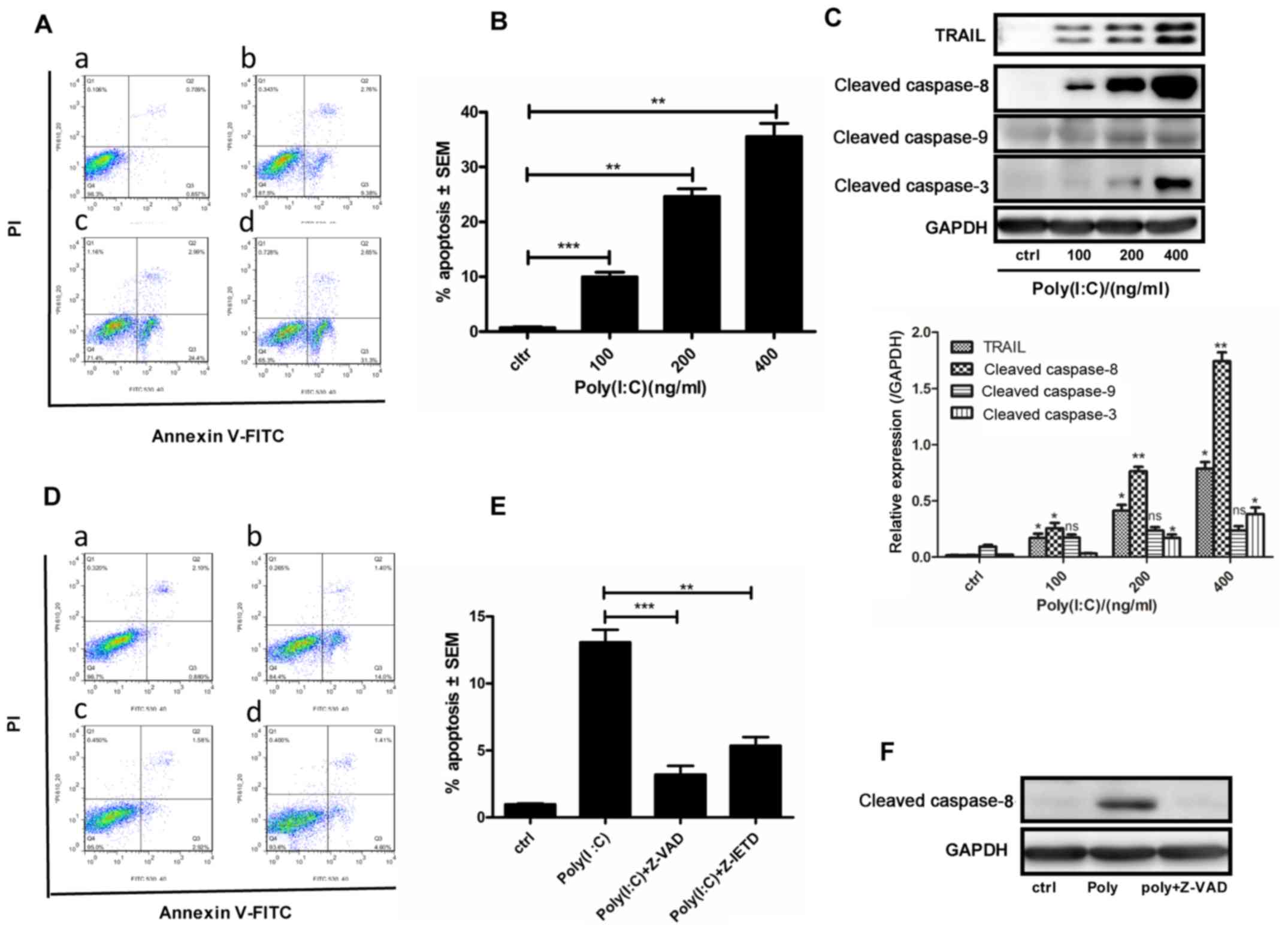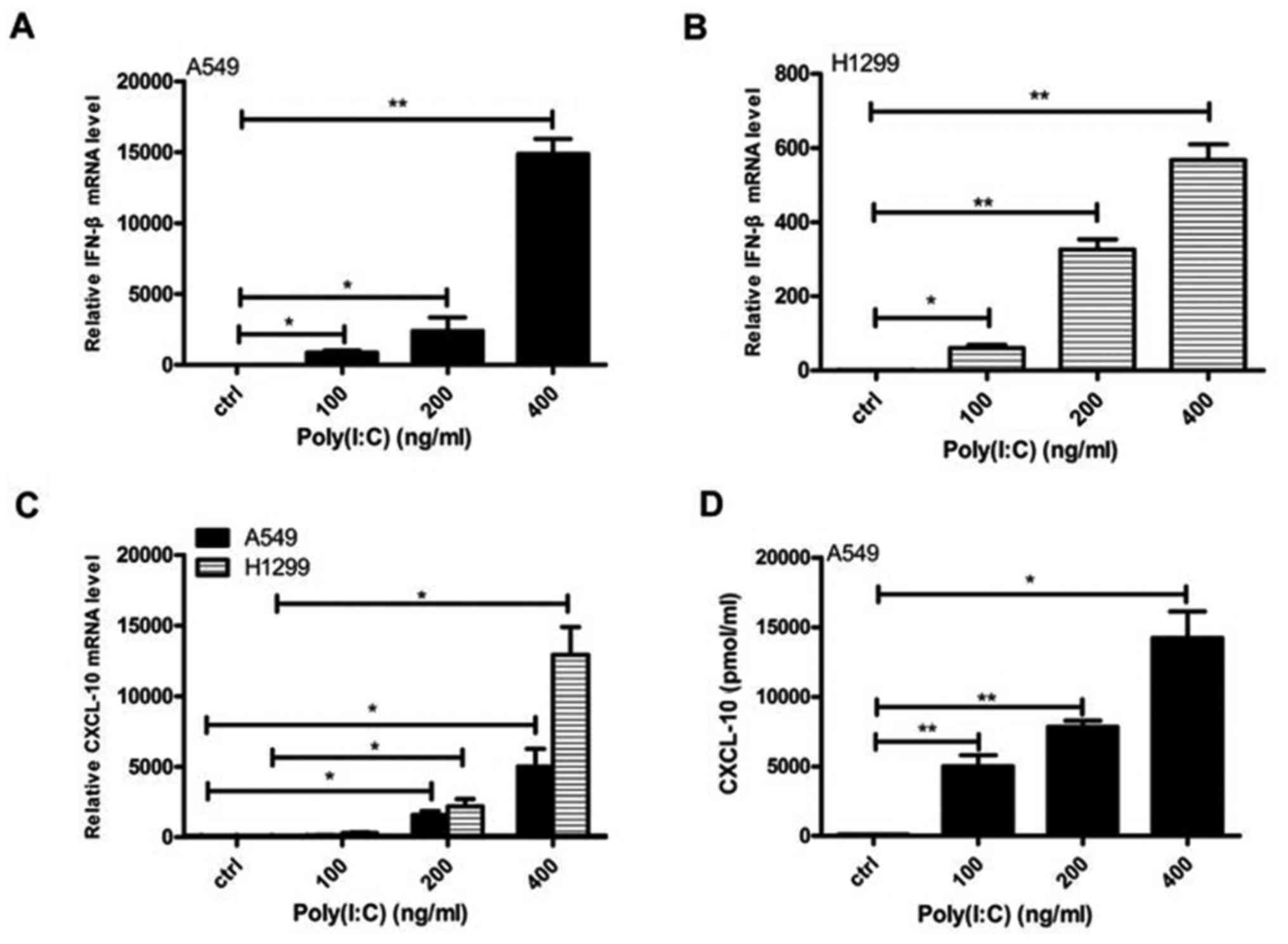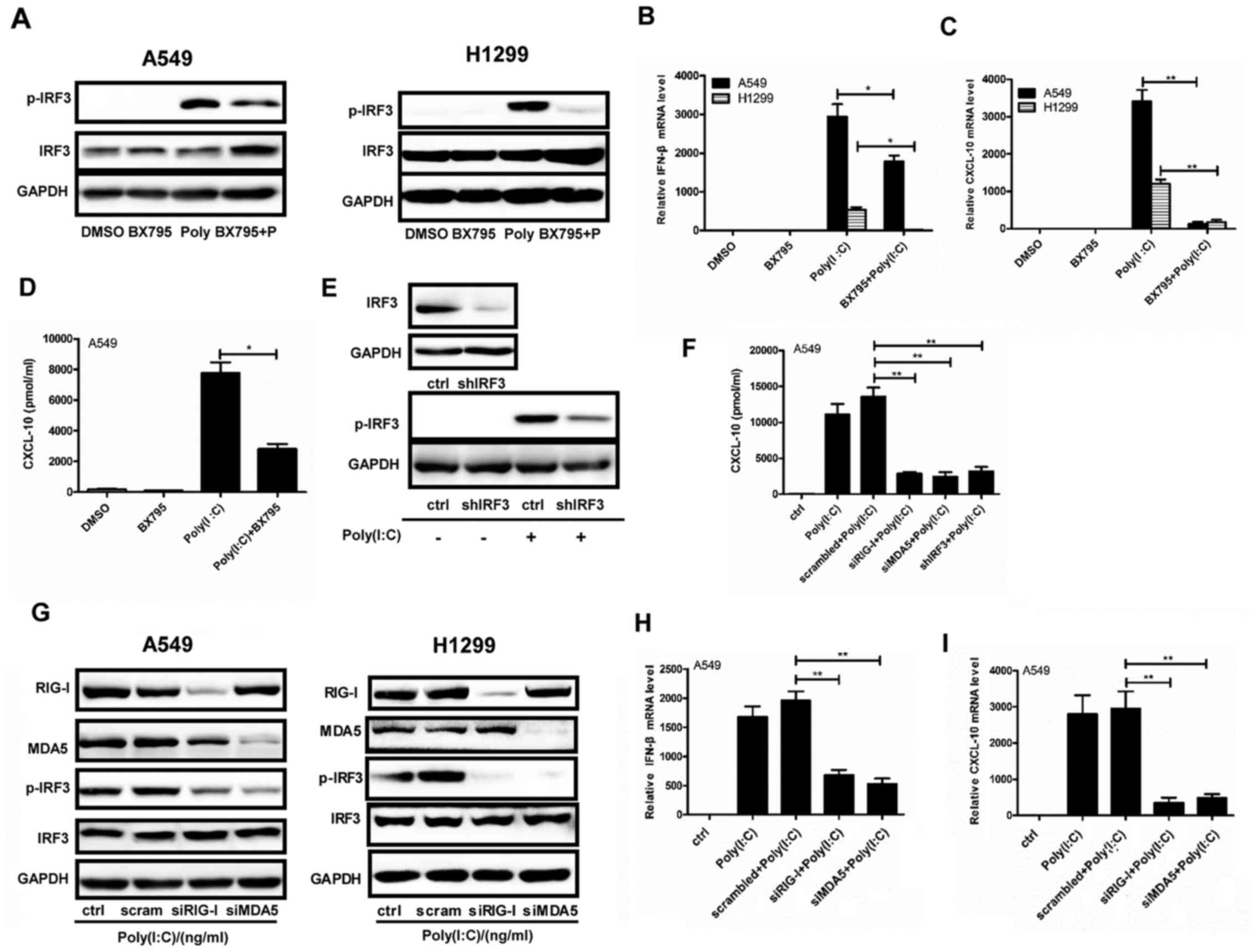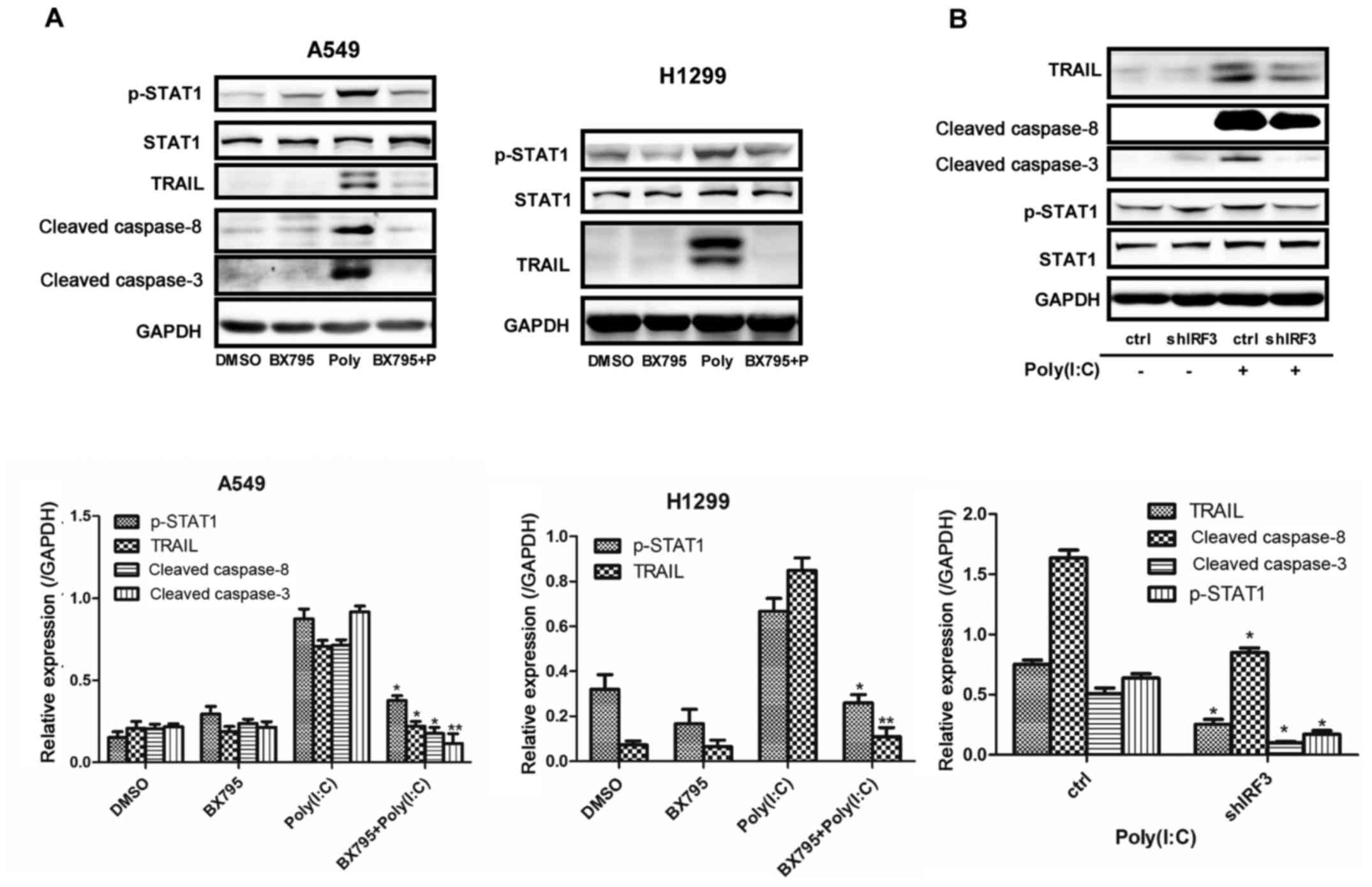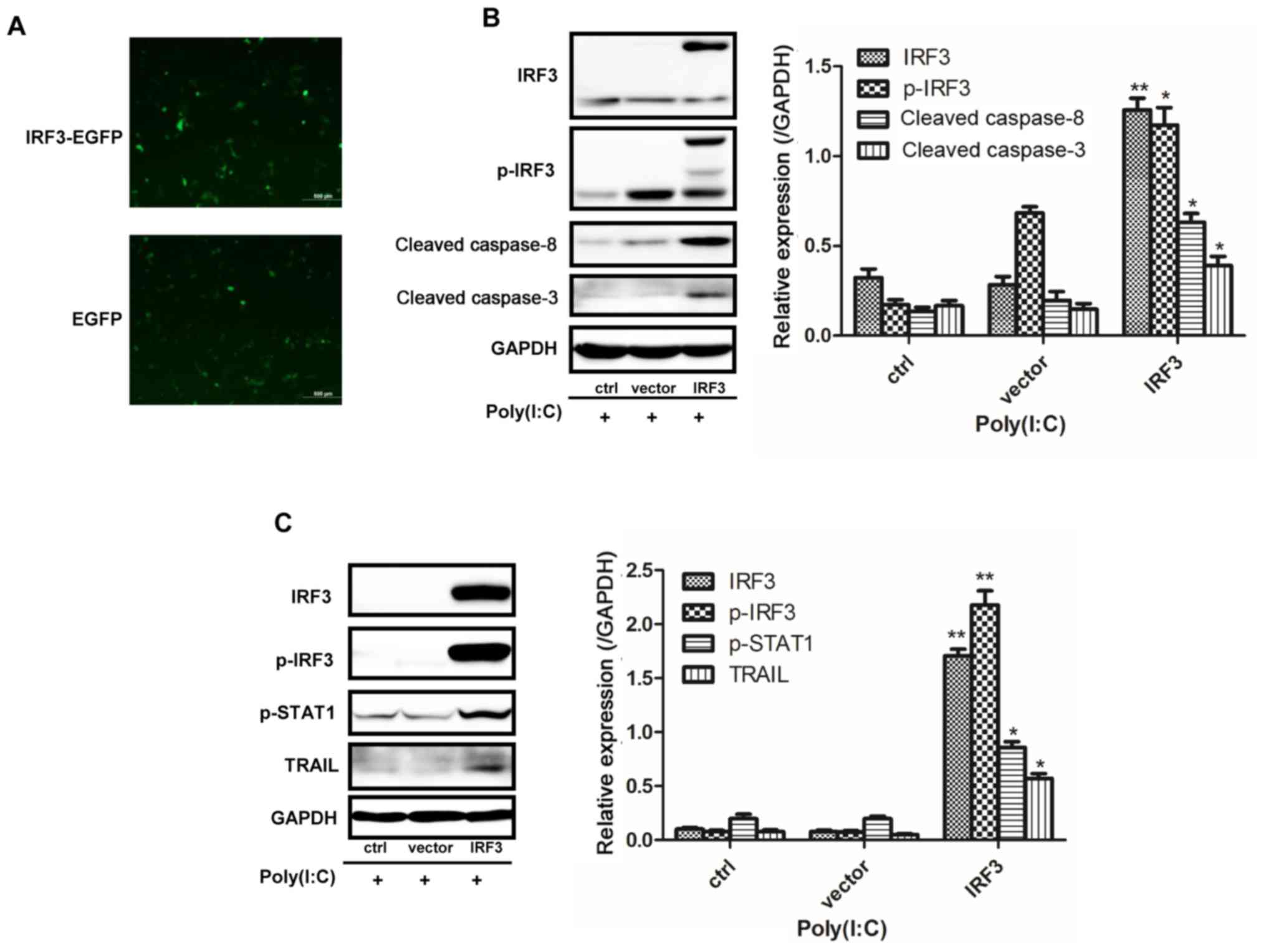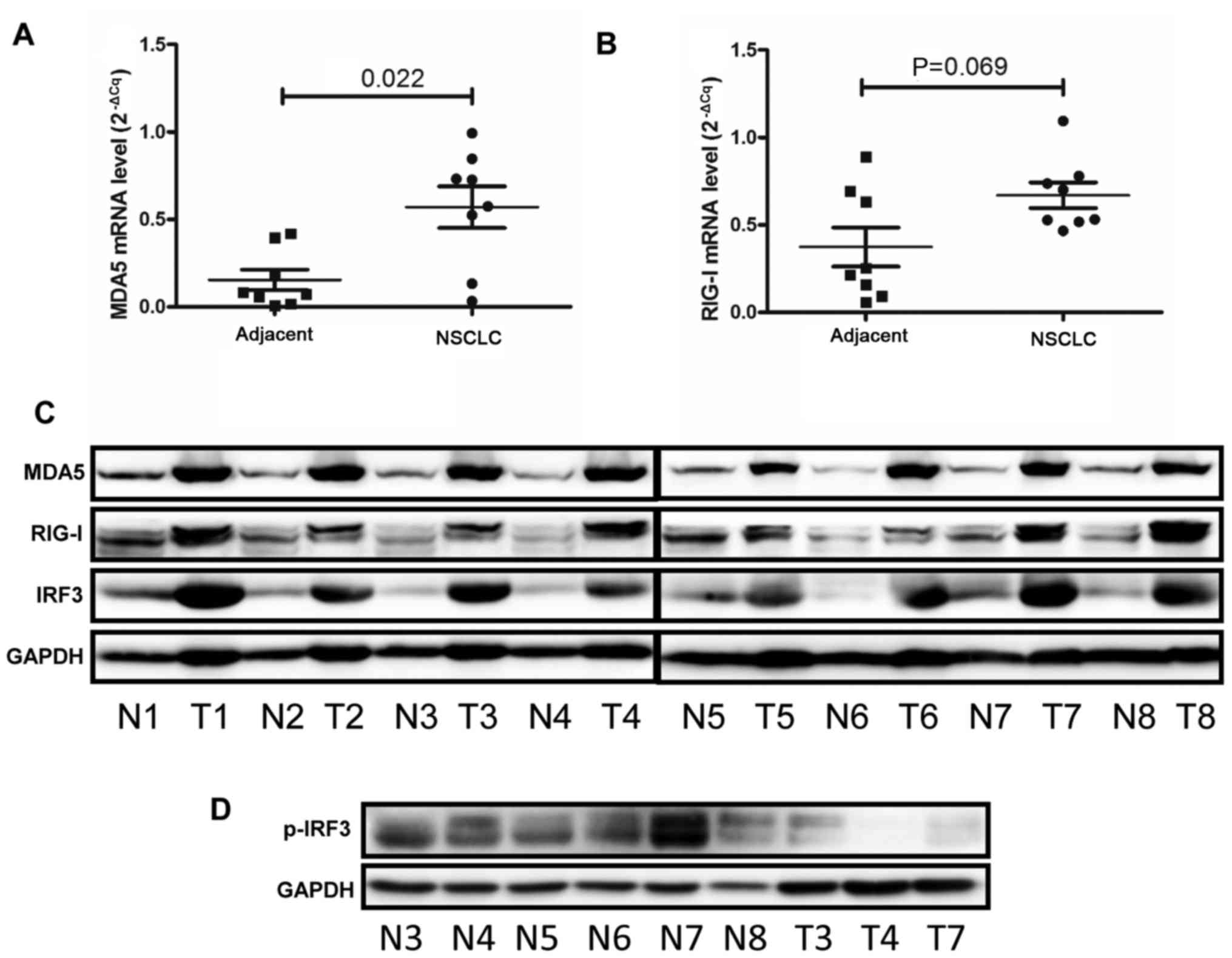|
1
|
Jin B, Cheng LF, Wu K, Yu XH and Yeo AE:
Application of dsRNA in cancer immunotherapy: Current status and
future trends. Anticancer Agents Med Chem. 14:241–255. 2014.
View Article : Google Scholar
|
|
2
|
Jin B, Sun T, Yu XH, Liu CQ, Yang YX, Lu
P, Fu SF, Qiu HB and Yeo AE: Immunomodulatory effects of dsRNA and
its potential as vaccine adjuvant. J Biomed Biotechnol.
2010:6904382010. View Article : Google Scholar : PubMed/NCBI
|
|
3
|
Cui J, Chen Y, Wang HY and Wang RF:
Mechanisms and pathways of innate immune activation and regulation
in health and cancer. Hum Vaccin Immunother. 10:3270–3285. 2014.
View Article : Google Scholar
|
|
4
|
Kawai T and Akira S: Signaling to
NF-kappaB by Toll-like receptors. Trends Mol Med. 13:460–469. 2007.
View Article : Google Scholar : PubMed/NCBI
|
|
5
|
Kumar S, Ingle H, Mishra S, Mahla RS,
Kumar A, Kawai T, Akira S, Takaoka A, Raut AA and Kumar H: IPS-1
differentially induces TRAIL, BCL2, BIRC3 and PRKCE in type I
interferons-dependent and -independent anticancer activity. Cell
Death Dis. 6:e17582015. View Article : Google Scholar : PubMed/NCBI
|
|
6
|
Zhao X, Ai M, Guo Y, Zhou X, Wang L, Li X
and Yao C: Poly I:C-induced tumor cell apoptosis mediated by
pattern-recognition receptors. Cancer Biother Radiopharm.
27:530–534. 2012. View Article : Google Scholar : PubMed/NCBI
|
|
7
|
Clément JF, Bibeau-Poirier A, Gravel SP,
Grandvaux N, Bonneil E, Thibault P, Meloche S and Servant MJ:
Phosphorylation of IRF-3 on Ser 339 generates a hyperactive form of
IRF-3 through regulation of dimerization and CBP association. J
Virol. 82:3984–3996. 2008. View Article : Google Scholar : PubMed/NCBI
|
|
8
|
Escalante CR, Nistal-Villán E, Shen L,
García-Sastre A and Aggarwal AK: Structure of IRF-3 bound to the
PRDIII-I regulatory element of the human interferon-beta enhancer.
Mol Cell. 26:703–716. 2007. View Article : Google Scholar : PubMed/NCBI
|
|
9
|
Tarassishin L and Lee SC: Interferon
regulatory factor 3 alters glioma inflammatory and invasive
properties. J Neurooncol. 113:185–194. 2013. View Article : Google Scholar : PubMed/NCBI
|
|
10
|
Romieu-Mourez R, Solis M, Nardin A, Goubau
D, Baron-Bodo V, Lin R, Massie B, Salcedo M and Hiscott J: Distinct
roles for IFN regulatory factor (IRF)-3 and IRF-7 in the activation
of antitumor properties of human macrophages. Cancer Res.
66:10576–10585. 2006. View Article : Google Scholar : PubMed/NCBI
|
|
11
|
Duan Y, Li Z, Cheng S, Chen Y, Zhang L, He
J, Liao Q, Yang L, Gong Z and Sun LQ: Nasopharyngeal carcinoma
progression is mediated by EBER-triggered inflammation via the
RIG-I pathway. Cancer Lett. 361:67–74. 2015. View Article : Google Scholar : PubMed/NCBI
|
|
12
|
Gambara G, Desideri M, Stoppacciaro A,
Padula F, De Cesaris P, Starace D, Tubaro A, Del Bufalo D,
Filippini A, Ziparo E, et al: TLR3 engagement induces
IRF-3-dependent apoptosis in androgen-sensitive prostate cancer
cells and inhibits tumour growth in vivo. J Cell Mol Med.
19:327–339. 2015. View Article : Google Scholar :
|
|
13
|
Moore TC, Kumm PM, Brown DM and Petro TM:
Interferon response factor 3 is crucial to poly-I:C induced NK cell
activity and control of B16 melanoma growth. Cancer Lett.
346:122–128. 2014. View Article : Google Scholar :
|
|
14
|
Palchetti S, Starace D, De Cesaris P,
Filippini A, Ziparo E and Riccioli A: Transfected poly(I:C)
activates different dsRNA receptors, leading to apoptosis or
immunoadjuvant response in androgen-independent prostate cancer
cells. J Biol Chem. 290:5470–5483. 2015. View Article : Google Scholar : PubMed/NCBI
|
|
15
|
Tian WL, Jiang ZX, Wang F, Guo R, Tang P,
Huang YM and Sun L: IRF3 is involved in human acute myeloid
leukemia through regulating the expression of miR-155. Biochem
Biophys Res Commun. 478:1130–1135. 2016. View Article : Google Scholar
|
|
16
|
Tokunaga T, Naruke Y, Shigematsu S, Kohno
T, Yasui K, Ma Y, Chua KJ, Katayama I, Nakamura T, Hishikawa Y, et
al: Aberrant expression of interferon regulatory factor 3 in human
lung cancer. Biochem Biophys Res Commun. 397:202–207. 2010.
View Article : Google Scholar : PubMed/NCBI
|
|
17
|
Tatsuta T, Imaizumi T, Shimoyama T, Sawaya
M, Kunikazu T, Matsumiya T, Yoshida H, Satoh K and Fukuda S:
Expression of melanoma differentiation associated gene 5 is
increased in human gastric mucosa infected with Helicobacter
pylori. J Clin Pathol. 65:839–843. 2012. View Article : Google Scholar : PubMed/NCBI
|
|
18
|
Le Goffic R, Pothlichet J, Vitour D,
Fujita T, Meurs E, Chignard M and Si-Tahar M: Cutting Edge:
Influenza A virus activates TLR3-dependent inflammatory and
RIG-I-dependent antiviral responses in human lung epithelial cells.
J Immunol. 178:3368–3372. 2007. View Article : Google Scholar : PubMed/NCBI
|
|
19
|
Guo R, Li Y, Ning J, Sun D, Lin L and Liu
X: HnRNP A1/A2 and SF2/ASF regulate alternative splicing of
interferon regulatory factor-3 and affect immunomodulatory
functions in human non-small cell lung cancer cells. PLoS One.
8:e627292013. View Article : Google Scholar : PubMed/NCBI
|
|
20
|
Livak KJ and Schmittgen TD: Analysis of
relative gene expression data using real-time quantitative PCR and
the 2(-Delta Delta C(T)) Method. Methods. 25:402–408. 2001.
View Article : Google Scholar
|
|
21
|
Yoboua F, Martel A, Duval A, Mukawera E
and Grandvaux N: Respiratory syncytial virus-mediated NF-kappa B
p65 phosphorylation at serine 536 is dependent on RIG-I, TRAF6, and
IKK beta. J Virol. 84:7267–7277. 2010. View Article : Google Scholar : PubMed/NCBI
|
|
22
|
Parsons KS, Hsu AC and Wark PA: TLR3 and
MDA5 signalling, although not expression, is impaired in asthmatic
epithelial cells in response to rhinovirus infection. Clin Exp
Allergy. 44:91–101. 2014. View Article : Google Scholar
|
|
23
|
Cheng YS and Xu F: Anticancer function of
polyinosinic-polycytidylic acid. Cancer Biol Ther. 10:1219–1223.
2010. View Article : Google Scholar : PubMed/NCBI
|
|
24
|
Chattopadhyay S and Sen GC:
dsRNA-activation of TLR3 and RLR signaling: Gene
induction-dependent and independent effects. J Interferon Cytokine
Res. 34:427–436. 2014. View Article : Google Scholar : PubMed/NCBI
|
|
25
|
Geiss G, Jin G, Guo J, Bumgarner R, Katze
MG and Sen GC: A comprehensive view of regulation of gene
expression by double-stranded RNA-mediated cell signaling. J Biol
Chem. 276:30178–30182. 2001. View Article : Google Scholar : PubMed/NCBI
|
|
26
|
Clark K, Plater L, Peggie M and Cohen P:
Use of the pharmaco-logical inhibitor BX795 to study the regulation
and physiological roles of TBK1 and IkappaB kinase epsilon: A
distinct upstream kinase mediates Ser-172 phosphorylation and
activation. J Biol Chem. 284:14136–14146. 2009. View Article : Google Scholar :
|
|
27
|
Duewell P, Beller E, Kirchleitner SV,
Adunka T, Bourhis H, Siveke J, Mayr D, Kobold S, Endres S and
Schnurr M: Targeted activation of melanoma
differentiation-associated protein 5 (MDA5) for immunotherapy of
pancreatic carcinoma. OncoImmunology. 4:e10296982015. View Article : Google Scholar : PubMed/NCBI
|
|
28
|
Kübler K, tho Pesch C, Gehrke N, Riemann
S, Dassler J, Coch C, Landsberg J, Wimmenauer V, Pölcher M,
Rudlowski C, et al: Immunogenic cell death of human ovarian cancer
cells induced by cytosolic poly(I:C) leads to myeloid cell
maturation and activates NK cells. Eur J Immunol. 41:3028–3039.
2011. View Article : Google Scholar : PubMed/NCBI
|
|
29
|
Bernardo AR, Cosgaya JM, Aranda A and
Jiménez-Lara AM: Synergy between RA and TLR3 promotes type I
IFN-dependent apoptosis through upregulation of TRAIL pathway in
breast cancer cells. Cell Death Dis. 4:e4792013. View Article : Google Scholar : PubMed/NCBI
|
|
30
|
Kiraz Y, Adan A, Kartal Yandim M and Baran
Y: Major apoptotic mechanisms and genes involved in apoptosis.
Tumour Biol. 37:8471–8486. 2016. View Article : Google Scholar : PubMed/NCBI
|
|
31
|
Kirshner JR, Karpova AY, Kops M and Howley
PM: Identification of TRAIL as an interferon regulatory factor 3
transcriptional target. J Virol. 79:9320–9324. 2005. View Article : Google Scholar : PubMed/NCBI
|
|
32
|
Cheon H, Borden EC and Stark GR:
Interferons and their stimulated genes in the tumor
microenvironment. Semin Oncol. 41:156–173. 2014. View Article : Google Scholar : PubMed/NCBI
|
|
33
|
Stephanou A and Latchman DS: STAT-1: A
novel regulator of apoptosis. Int J Exp Pathol. 84:239–244. 2003.
View Article : Google Scholar
|
|
34
|
Doi T, Ishikawa T, Okayama T, Oka K,
Mizushima K, Yasuda T, Sakamoto N, Katada K, Kamada K, Uchiyama K,
et al: The JAK/STAT pathway is involved in the upregulation of
PD-L1 expression in pancreatic cancer cell lines. Oncol Rep.
37:1545–1554. 2017. View Article : Google Scholar
|
|
35
|
No authors listed: RIG-I is a tumor
suppressor and biomarker of IFN-alpha efficacy in HCC. Cancer
Discov. 4:OF122014. View Article : Google Scholar
|
|
36
|
Coussens LM and Werb Z: Inflammation and
cancer. Nature. 420:860–867. 2002. View Article : Google Scholar : PubMed/NCBI
|
|
37
|
Andersen LL, Mørk N, Reinert LS,
Kofod-Olsen E, Narita R, Jørgensen SE, Skipper KA, Höning K, Gad
HH, Østergaard L, et al: Functional IRF3 deficiency in a patient
with herpes simplex encephalitis. J Exp Med. 212:1371–1379. 2015.
View Article : Google Scholar : PubMed/NCBI
|



